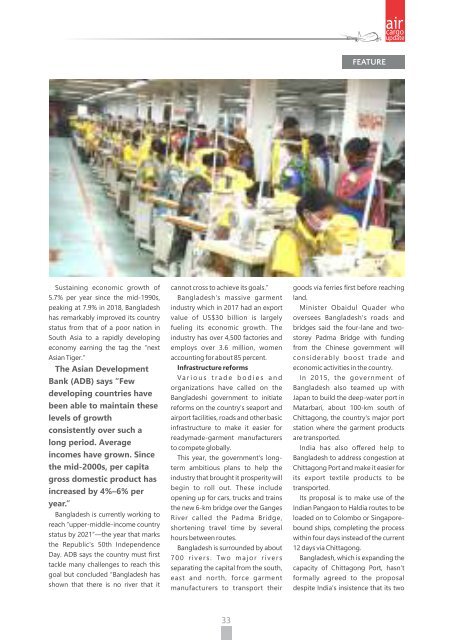ACU
Create successful ePaper yourself
Turn your PDF publications into a flip-book with our unique Google optimized e-Paper software.
FEATURE<br />
Sustaining economic growth of<br />
5.7% per year since the mid-1990s,<br />
peaking at 7.9% in 2018, Bangladesh<br />
has remarkably improved its country<br />
status from that of a poor nation in<br />
South Asia to a rapidly developing<br />
economy earning the tag the “next<br />
Asian Tiger.”<br />
The Asian Development<br />
Bank (ADB) says “Few<br />
developing countries have<br />
been able to maintain these<br />
levels of growth<br />
consistently over such a<br />
long period. Average<br />
incomes have grown. Since<br />
the mid-2000s, per capita<br />
gross domestic product has<br />
increased by 4%–6% per<br />
year.”<br />
Bangladesh is currently working to<br />
reach “upper-middle-income country<br />
status by 2021”—the year that marks<br />
the Republic's 50th Independence<br />
Day. ADB says the country must first<br />
tackle many challenges to reach this<br />
goal but concluded “Bangladesh has<br />
shown that there is no river that it<br />
cannot cross to achieve its goals.”<br />
Bangladesh's massive garment<br />
industry which in 2017 had an export<br />
value of US$30 billion is largely<br />
fueling its economic growth. The<br />
industry has over 4,500 factories and<br />
employs over 3.6 million, women<br />
accounting for about 85 percent.<br />
Infrastructure reforms<br />
Va r i o u s t r a d e b o d i e s a n d<br />
organizations have called on the<br />
Bangladeshi government to initiate<br />
reforms on the country's seaport and<br />
airport facilities, roads and other basic<br />
infrastructure to make it easier for<br />
readymade-garment manufacturers<br />
to compete globally.<br />
This year, the government's longterm<br />
ambitious plans to help the<br />
industry that brought it prosperity will<br />
begin to roll out. These include<br />
opening up for cars, trucks and trains<br />
the new 6-km bridge over the Ganges<br />
River called the Padma Bridge,<br />
shortening travel time by several<br />
hours between routes.<br />
Bangladesh is surrounded by about<br />
7 0 0 r i v e r s . Tw o m a j o r r i v e r s<br />
separating the capital from the south,<br />
east and north, force garment<br />
manufacturers to transport their<br />
goods via ferries first before reaching<br />
land.<br />
Minister Obaidul Quader who<br />
oversees Bangladesh's roads and<br />
bridges said the four-lane and twostorey<br />
Padma Bridge with funding<br />
from the Chinese government will<br />
considerably boost trade and<br />
economic activities in the country.<br />
In 2015, the government of<br />
Bangladesh also teamed up with<br />
Japan to build the deep-water port in<br />
Matarbari, about 100-km south of<br />
Chittagong, the country's major port<br />
station where the garment products<br />
are transported.<br />
India has also offered help to<br />
Bangladesh to address congestion at<br />
Chittagong Port and make it easier for<br />
its export textile products to be<br />
transported.<br />
Its proposal is to make use of the<br />
Indian Pangaon to Haldia routes to be<br />
loaded on to Colombo or Singaporebound<br />
ships, completing the process<br />
within four days instead of the current<br />
12 days via Chittagong.<br />
Bangladesh, which is expanding the<br />
capacity of Chittagong Port, hasn't<br />
formally agreed to the proposal<br />
despite India's insistence that its two

















